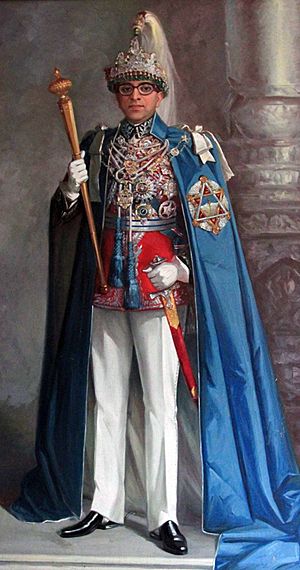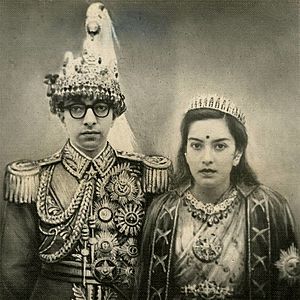Mahendra of Nepal facts for kids
Quick facts for kids Mahendra Bir Bikram Shah Dev |
|
|---|---|
 |
|
| King of Nepal | |
| Reign | 13 March 1955 – 31 January 1972 |
| Coronation | 2 May 1956 |
| Predecessor | Tribhuvan |
| Successor | Birendra |
| Born | 11 June 1920 Narayanhity Royal Palace Kathmandu, Kingdom of Nepal |
| Died | 31 January 1972 (aged 51) Diyalo Bangala, Bharatpur, Kingdom of Nepal |
| Spouse | Crown Princess Indra Rajya Lakshmi Devi (m. 1940–1950, her death) Queen Ratna Rajya Lakshmi Devi (m. 1952–1972, his death) |
| Issue | Princess Shanti Princess Sharada King Birendra King Gyanendra Princess Shobha Prince Dhirendra |
| Dynasty | Shah dynasty |
| Father | Tribhuvan of Nepal |
| Mother | Kanti Rajya Lakshmi Devi |
| Religion | Hindu |
Mahendra Bir Bikram Shah Dev (Nepali: महेन्द्र वीर विक्रम शाह; 11 June 1920 – 31 January 1972) was King of Nepal from 1955 to 1972. Mahendra was born on 11 June 1920 to King Tribhuvan of Nepal. Although Tribhuvan was nominally king since 1911. Mahendra was captive in Narayanhity Royal Palace, virtually a gilded cage. In 1940 he married Indra Rajya Lakshmi Devi, daughter of General Hari Shamsher Jang Bahadur Rana. Mahendra had three sons, Birendra, Gyanendra, and Dhirendra and three daughters Shanti, Sharada, and Shobha. Crown Princess Indra died in 1950. In 1952, Mahendra married Indra's younger sister, Ratna Rajya Lakshmi Devi. This marriage produced no children as King Mahendra had married on the condition his personal life shall not hinder his national duties and the to be queen agreed to be childless.
Contents
Reign
Mahendra succeeded Tribhuvan as King of Nepal. He was crowned on 2 May 1956.
1960 Coup d'état
On 15 December 1960, the then King Mahendra suspended the constitution, dissolved the elected parliament, dismissed the cabinet, imposed direct rule and imprisoned the then-prime minister B. P. Koirala and his closest government colleagues. Mahendra instituted a Panchayat hierarchical system of village, district and national councils, a variant of guided democracy. He pursued a foreign policy of neutrality between China and India.
Rule in Panchayat System (1960–72)
In 1960, King Mahendra used his emergency powers and took charge of the State once again claiming that the Congress government had fostered corruption, promoted party above national interest, failed to maintain law and order and encouraged anti-national elements. Political parties were outlawed and all prominent political figures, including the Prime Minister were put behind bars. Civil liberties were curtailed and press freedom muzzled. King Mahendra, then, through an exercise of the sovereign power and prerogatives inherent in us promulgated a new constitution on December, 1962 introducing a party-less Panchayat system. The political system (Panchayat System) was a party-less "guided" democracy in which the people could elect their representatives, while real power remained in the hands of the monarch. Dissenters were called anti-national elements.
The Panchayat System was formulated by King Mahendra after overthrowing the first democratically elected government and dissolving the parliament in 1960. On 26 December 1961, King Mahendra appointed a council of 5 ministers to help run the administration. Several weeks later, political parties were declared illegal. At first, the Nepali Congress leadership propounded a non-violent struggle against the new order and formed alliances with several political parties, including the Gorkha Parishad and the United Democratic Party. Early in 1961, however, the king had set up a committee of 4 officials from the Central Secretariat to recommend changes in the constitution that would abolish political parties and substitute a "National Guidance" system based on local panchayat led directly by the king.
Mahendra implemented a land reform policy, which provided land to many landless people. The Mahendra Highway (also called East-West Highway) that runs along the entire Terai belt in southern Nepal was constructed during his reign. He launched the Back to the Village National Campaign in 1967 which was one of his largest rural development efforts. He also played a key role in making Nepal a member of the United Nations in 1955.
British Field Marshal
King Mahendra was appointed as a British Field Marshal in 1962.
King Mahendra and Queen's visit to USA in 1967
King Mahendra and the Queen Ratna were greeted by the then President of USA, Lyndon B Johnson and Mrs. Johnson in Washington DC in 1967. The royal couple of Nepal was greeted with the 'guard of honor'.
Hobbies
Mahendra went in for various activities like noblemen of his era and subsequent eras. King Mahendra wrote songs and poems. He is also called the first lyricist of Nepal by some sources. He penned Lolayeka Tee, Gajali Tee Thula Thula Aakha, Garchin Pukar Aaama, Aakashma Tirmire, Kina Kina Timro Tasbir, etc. which were later sung by Gulam Ali and Lata Mangeshar.
Death and succession
Mahendra suffered a massive second heart attack whilst on a winter hunting trip in Chitwan where he was attended to by his trusted Physicians Dr Mrigendra Raj Pandey and Dr Sachey Kumar Pahari. King Mahendra was in a stable but critical condition and eventually breathed his last at Diyalo Bangala, the royal palace in Bharatpur on 31 January 1972. The King's body was subsequently flown to Kathmandu by helicopter in preparation for the State Funeral.
His son Birendra assumed the throne on 24 February 1975 but perished in the Nepalese royal massacre on 1 June 2001.
Honors
- Sovereign of the Order of Nepal Pratap Bhaskara
- Sovereign of the Order of Ojaswi Rajanya
- Sovereign of the Order of Nepal Taradisha
- Sovereign of the Order of Tri Shakti Patta
- Sovereign of the Order of Gorkha Dakshina Bahu
- Most Glorious Mahendra Chain (26 February 1961)
- Commemorative Silver Jubilee Medal of King Tribhuvan (11 December 1936)
 Iran: Grand Collar of the Order of Pahlavi, 3 July 1960
Iran: Grand Collar of the Order of Pahlavi, 3 July 1960 Iran: Commemorative Medal of the 2500th Anniversary of the founding of the Persian Empire, 14 October 1971.
Iran: Commemorative Medal of the 2500th Anniversary of the founding of the Persian Empire, 14 October 1971. Japan: Collar of the Order of the Chrysanthemum, 19 April 1960
Japan: Collar of the Order of the Chrysanthemum, 19 April 1960 Portugal: Grand Cross of the Order of Saint James of the Sword, 13 July 1960
Portugal: Grand Cross of the Order of Saint James of the Sword, 13 July 1960 France: Grand Cross of the Order of Legion of Honour, 24 February 1956
France: Grand Cross of the Order of Legion of Honour, 24 February 1956 Finland: Grand Cross with Collar of the Order of the White Rose, 1958
Finland: Grand Cross with Collar of the Order of the White Rose, 1958 Belgium: Grand Cross of the Order of Leopold II, 1964
Belgium: Grand Cross of the Order of Leopold II, 1964 Germany: Grand Cross Special Class of the Order of Merit of the Federal Republic of Germany, 1964
Germany: Grand Cross Special Class of the Order of Merit of the Federal Republic of Germany, 1964 Kingdom of Laos: Collar of the Order of the Million Elephants and the White Parasol, 1970
Kingdom of Laos: Collar of the Order of the Million Elephants and the White Parasol, 1970 Pakistan: Nishan-e-Pakistan, 1970
Pakistan: Nishan-e-Pakistan, 1970 Netherlands Grand Cross of the Order of the Netherlands Lion, 25 April 1967.
Netherlands Grand Cross of the Order of the Netherlands Lion, 25 April 1967. United Kingdom: Royal Victorian Chain, 26 February 1961
United Kingdom: Royal Victorian Chain, 26 February 1961 Philippines: Collar of the Order of Sikatuna, Rank of Raja, 1971.
Philippines: Collar of the Order of Sikatuna, Rank of Raja, 1971.
Images for kids
See also
 In Spanish: Mahendra de Nepal para niños
In Spanish: Mahendra de Nepal para niños
















